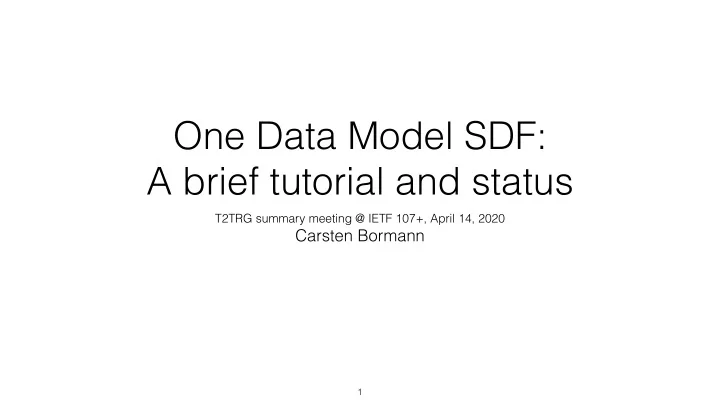

One Data Model SDF: A brief tutorial and status T2TRG summary meeting @ IETF 107+, April 14, 2020 Carsten Bormann 1
The need for One Data Model • IoT standardization is dominated by ecosystem -specific SDOs • Each ecosystem has their own data models, and their own way to document them • IoT applications may need to work with things from multiple ecosystems: No single ecosystem can supply the whole variety needed • Can build protocol translators; harder to translate hundreds of data models 2
The One Data Model liaison group • People from di ff erent SDOs meet in an informal liaison group • Bring together hundreds of ecosystem-specific data models • Express in common format • Work on merging and harmonizing data models • Make harmonized data models available for all SDOs (BSD license!) • Working in the open: https://github.com/one-data-model • Inevitably: standardize on a common format : SDF 3
SDF: The Simple Definition Format • https://github.com/one-data-model/language • Defines classes of things (odmObject, combine into odmThing) • Things don’t have data, they have interactions with their clients(*) , provided by a ff ordances (*) Not a oneDM term • Interaction a ff ordances grouped into interaction patterns : For now, Property, Action, Event • Interactions input and output data (groupable into odmData) 4
Interaction Patterns Name cf. REST Initiative Input Output • SDF is about Property GET Client — Data modeling data Property PUT Client Data (Data) • Interaction Patterns (writable) mostly defined along input and output data Action POST Client Input Output Event ? Thing — Output 5
Action Name cf. REST Initiative Input Output • Actions can have di ff erent input and Property GET Client — Data output data Property • Some actions take PUT Client Data Data (writable) time (not modeled): Initiative to return output moved to Action POST Client Input Output Thing (~ Event) Event ? Thing — Output 6
Property cf. REST Initiativ Name Input Output • Property is used for e data items that can be read by the client Property GET Client — Data • Writable properties Property can also be “set” (no PUT Client Data (Data) (writable) special output) Property GET Client, • Observable — Data (observable) (observe) Thing properties look like an Event Event ? Thing — Output 7
Event • Least well-defined Name cf. REST Initiative Input Output interaction pattern • Is an Event just a Property GET Client — Data notification (similar to observable property)? Property PUT Client Data Data (writable) • Are Events just status updates (temperature) Action POST Client Input Output or is any single one of them precious (coin insertion)? Event ? Thing — Output 8
Data • Data is defined by their shape (as in data definition/“schema” languages) • Data definitions can be made inline in an a ff ordance definition or separately, for later reference • Definitions can use subset of json-schema.org terms, and/or SDF-specific terms such as contentFormat, nullable, scale… 9
odmThing, odmProduct • odmObject definitions can Insert magic here be combined into top-level structures • odmThing can contain odmObject and odmThing • odmProduct similar, as a (not to be harmonized) top-level product definition [figure modified from Michael J Koster] 10
Overall Specification Structure • One or more JSON documents; linked together with JSON pointers [RFC6901] • SDF specification can reuse elements (such as odmData definitions) of other SDF specifications • Goal: define a basic core set that every specification can reference (“common reusable definitions”) 11
Specifying SDF • SDF specs are JSON documents, can be specified in a data definition language • https://github.com/one-data-model/language/blob/master/sdf-schema.json using json-schema.org “JSON Schema” format • Do not confuse with selected json-schema.org terms used in SDF • Of course, also needs semantics • Definition: https://github.com/one-data-model/language/blob/master/sdf.md • Best practices: https://github.com/one-data-model/language/blob/master/ bestpractices.md • De-facto specifics via tooling at https://github.com/one-data-model/playground 12
Status 2020-04-14 • SDF spec is stable enough to submit data models • Stabilized in Stockholm F2F meeting (2019-10-01..-04) • Several hundred data models now collected at playground • Ecosystem SDOs have developed tools to convert their corpus to SDF • Specification itself needs more cleanup and an editorial round • 4-day online conference tentatively scheduled for weeks 19–21 • Should be completed by end of May 13
What’s next • Continue implementation work on the model- consuming side (e.g., WISHI hackathon on 2020-04-24) • Solve remaining issues for SDF 1.0 (to be done in liaison group) • Existing “playground” definitions serve as a corpus • Can fix all of these in place if needed for a non-backwards compatible change! • Next: Find a venue for standardization of SDF? 14
Recommend
More recommend